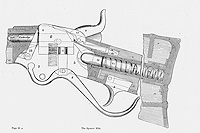Arms (Cannon and Gun)
Cannon
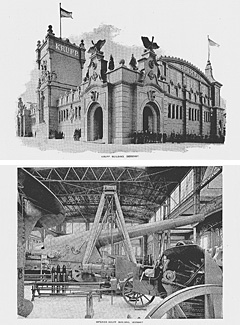 These are images of the Krupp Building exterior and a Krupp Gun at the Chicago International Exposition of 1893. Krupp, once a steel product manufacturing company, developed further after beginning to manufacture arms. The company's president, Alfred Krupp, was dubbed the "Cannon King." International expositions served as opportunities for countries to demonstrate their military power.
These are images of the Krupp Building exterior and a Krupp Gun at the Chicago International Exposition of 1893. Krupp, once a steel product manufacturing company, developed further after beginning to manufacture arms. The company's president, Alfred Krupp, was dubbed the "Cannon King." International expositions served as opportunities for countries to demonstrate their military power.
It was at the beginning of the 14th century that the full introduction of guns began. The early guns featured a muzzle-loading system, in which propellant charge and bullet were loaded from the muzzle of the weapon. In the 19th century, a modern breech-loading system was developed, in which ammunition was loaded at the rear of the weapon. This development significantly reduced the loading time and realized firing in rapid succession. One of the most renowned breech-loading rifles was the Armstrong Gun.
However, since they were made of hard and brittle pig iron or soft wrought iron, such guns burst easily. In this regard, the use of strong steel was required. In 1740, B. Huntsman of England invented the technique of making steel in a crucible, although the technique only allowed small-scale production. In Prussia, using the crucible technique, Krupp created a steel gun. He exhibited an ingot cannon weighing 4,500 pounds, one of the largest in those days, and a six pounder field gun at the London International Exposition of 1851, utterly astonishing visitors. These exhibits were made with the use of 98 crucibles.
In 1856, in England, H. Bessemer invented a new steel production process. This enabled the mass production of steel simply by blowing air through molten pig iron. He created a pear-shaped rotary converter. In 1859, he established Bessemer Steel Works, commencing the mass production of steel at low price.
Actually, it was the time of transition from the muzzle-loading system in which ammunition was loaded from the muzzle to the breech-loading system in which it was loaded at the rear. Krupp Co. manufactured a breech-loading gun of strong steel made by the Bessemer process. The company's guns began to be employed by troops in various countries, which culminated in the construction of the Krupp Building at the Chicago International Exposition of 1893.
After these technological improvements, guns increased in potential as weapons. In the 1880s, a recoil brake and a counter-recoil system were invented. While the former was designed to reduce the recoil upon firing, the latter returned the barrel to its standing position with the use of the recoil force. These inventions served as the foundation of modern guns. At the end of the 19th century, black powder, which had various defects, was replaced by smokeless powder invented by P. M. E. Vieille of France. This resulted in improvement in gun performance in terms of higher initial velocity, greater gun range, and an increase in the amount of ammunition carried.
Gun
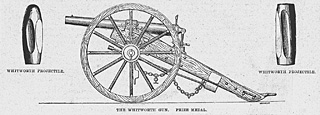 This is an image of the Whitworth Gun exhibited at the second London International Exposition of 1862. This exhibit was granted a gold medal. Whitworth rifles were employed by the Confederate Army during the American Civil War. The War promoted the creation of modern military items, significantly shaping the history of guns.
This is an image of the Whitworth Gun exhibited at the second London International Exposition of 1862. This exhibit was granted a gold medal. Whitworth rifles were employed by the Confederate Army during the American Civil War. The War promoted the creation of modern military items, significantly shaping the history of guns.
The history of guns is the history of improvements of their ignition/firing functions and loading systems. The history began with a matchlock system (the ignition system used for what were called "matchlock guns"), followed by a flintlock system, which caused a spark by striking a flint strongly against a rasp. The successor of the flintlock was a chemical system called a percussion lock developed in 1822. In the percussion lock system, mercury fulminate was ignited upon impact with a primer. Since percussion lock guns had no opening parts, excluding the muzzle, they were not affected by the weather.
All the three systems featured a muzzle loading system. In 19th century, however, the improvement of steel production technology increased the strength of steel, leading to a wide variety of efforts to develop breech-loading guns whose ammunition was loaded at the rear.
In 1836, J. N. von Dreyse, an engineer of Prussia, developed a needle gun. It can be said that the gun confirmed the superiority of breech-loading guns over their muzzle-loading counterparts. The needle gun was characterized by a bolt (a simple key-shaped one as would be used for fastening a door) placed at the breech to prevent gas leakage, which was a problem with breech-loading guns. It was also distinctive in that a long firing pin (which gave it the name "needle gun") pierced a paper cartridge containing ammunition, bullets, propellant charge and an explosion primer. Needle guns contributed to the Prussian army's military victories at the time of the unification of Germany. Meanwhile, the bolts still remain in use today as a bolt-action system.
As for metal cartridges, N. Flobert, a French gunsmith, exhibited a rim-fire cartridge at the first London International Exposition of 1851. In this cartridge, gunpowder, which served as a primer, was contained in the hollow rim around the outer circumference of the rear end of the cartridge. A strike on the rim caused ignition.
It was Smith & Wesson (S&W) that developed this rim-fire cartridge into a more practical form. Also, they were eager to develop revolver models. It can be said that Colt's Manufacturing, established in 1836 in the United States, completed the muzzle-loading revolver, and S&W Co. improved such revolvers into breech-loading ones. It was around that time that the long-awaited repeating guns were completed.
In 1860, S&W 32-caliber revolver models were employed by the Union Army. Their use in the American Civil War quickly raised the profile of revolvers. The revolver was a pistol. As weapons for firing shots in quick succession on the shoulder of an operator, repeating rifles with a magazine in the gunstock were also used at the war. The image on the right depicts a structural drawing of a breech-loading repeating rifle exhibited at the Paris International Exposition of 1867.
Subsequently, defects of the rim-fire cartridge, which was inappropriate for guns with large calibers, were corrected, leading to the improvement of a higher pressure resistant centerfire cartridge. The new cartridge had an ignition primer in the center of the base of the cartridge, which became the norm. As well as in the case of the guns described in the section of "Cannon," the invention of smokeless powder facilitated the practical use of repeating guns. Such powder began to be used in many countries.
Cannon (20 images)
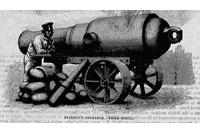 |
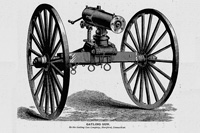 |
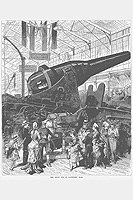 |
| Ordnance Exhibited by T.W. Blakely | Gatling Gun Exhibited by Gatling Gun Co. | Krupp Gun and Viewers |
Gun (16 images)
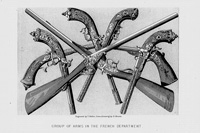 |
 |
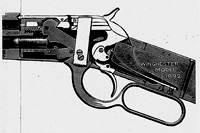 |
| Guns Made in France | Pistol Made by Feanne & Deanne | Repeating Gun Made by Winchester Repeating Arms Co., 1892 Model |
- References:
Iwado, Kenjin.: Sekai juhoshi (Kokusho kankokai, 1995) <PS141-G2>
Kashima, Shigeru.: Pari banpaku zekkei hakubutsukan (25) Furansu ni okeru seiko kakumei in Seko n. 382 (1997.8) <Z16-72>
Manchester, William Raymond; Suzuki, Chikara (tr).: Kuruppu no rekishi: 1587-1968 (Fuji shuppansha, 1982) <GK21-44>
Miyake, Koji.: Kuruppusha no jukyu seiki – Futari no kuruppu, bankoku hakurankai, nihon - in Yoshida, Mitsukuni (ed).: Bankoku hakurankai no kenkyu (Shibunkaku shuppan, 1986) <D7-71>
Morota, Minoru.: Kuruppu (Toyo keizai shinposha, 1970) <DH26-10>

